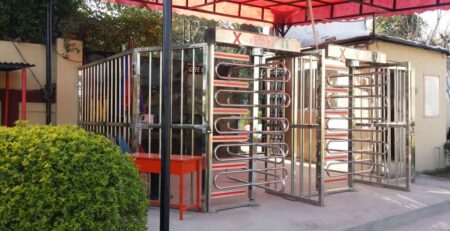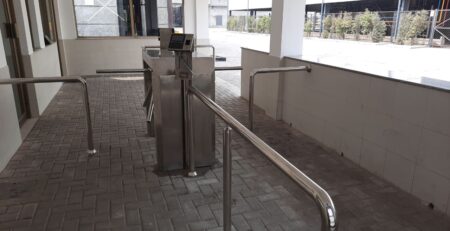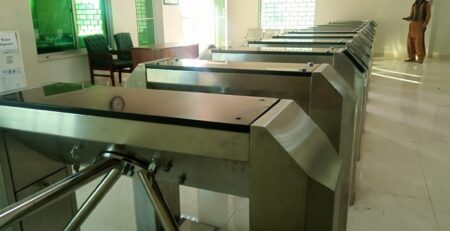Flap Barriers or Turnstiles – What’s Best for Secure Access Control?
In today’s high-traffic spaces, security isn’t just a requirement, it’s a critical part of managing people safely and efficiently. Whether it’s the front lobby of a corporate tower, the entrance to a busy metro station, or the gate of a large construction site, having the right access control system makes all the difference.
Two of the most widely used access solutions are flap barriers and turnstiles. Although they may seem similar at first glance, they serve distinctly different purposes, depending on the environment, security needs, and user expectations.
This guide breaks down their key differences to help you choose the best fit for your facility.
How They Work: Two Very Different Systems
Flap Barriers: Fast, Smart, and Sleek
Flap barriers are designed for speed and sophistication. These systems feature motorized panels usually made from acrylic or polycarbonate that retract into the body of the unit once access is granted. Commonly integrated with RFID, bio-metric scanners, QR code readers, or even facial recognition technology, they support a completely contactless entry experience.
Once a valid credential is scanned, the flaps slide open instantly, allowing one person through. Advanced sensors prevent tailgating, ensuring that only one person is allowed to enter at a time, as authorized. With modern aesthetics and seamless operation, flap barriers are designed for environments where appearance and speed are just as important as security.
Turnstiles: Tough, Reliable, and Purpose-Built
Turnstiles are the workhorses of physical security. Available in tripod, full-height, or waist-high configurations, they use rotating arms to control access only unlocking momentarily once valid entry is confirmed. A person must physically push through or pass, which acts as a deterrent to unauthorized access.
These systems don’t rely heavily on electronics, making them ideal for areas with unstable power or harsh environmental conditions. Factories, stadiums, and remote access points often rely on turnstiles to ensure rugged, controlled entry even during high-volume foot traffic.

Where They Fit Best: Matching System to Site
Best Environments for Flap Barriers
Flap barriers are most commonly found in:
- Corporate buildings
- Airports and metro stations
- Government offices
- Hotels and conference centres
These locations prioritise not just security but also a premium, contactless experience. Flap barriers create a clean, modern entrance without sacrificing access control. Their quiet and elegant design makes them a favourite in high-end environments.
Best Environments for Turnstiles
Turnstiles are better suited for:
- Industrial zones and factories
- Construction sites
- Stadiums and arenas
- Warehouses and outdoor checkpoints
Their robust build and strong physical presence make them ideal for challenging or exposed environments. When security enforcement and throughput control are key, turnstiles stand their ground literally and figuratively.
Explore More On Turnstiles!Side-by-Side Comparison: Flap Barriers vs Turnstiles
| Feature | Flap Barriers | Turnstiles |
| Access Speed | Fast and seamless | Moderate, one-at-a-time |
| Entry Type | Fully contactless | Partially contact-based |
| Look & Feel | Sleek and modern | Rugged and Industrial |
| Anti-Tailgating | High precision (infrared) | Moderate control |
| Ideal Use | Indoors | Indoors & Outdoors |
| Cost | Higher (due to tech) | Generally lower |
| Maintenance | Needs regular upkeep | Low maintenance |
| Power Requirement | Fully electric | Mechanical options available |
Key Considerations: What Matters Most to You?
Security
If your top priority is physical deterrence, especially in outdoor or less-monitored areas, turnstiles offer unmatched durability and security. Their heavy arms are difficult to bypass and work well in zones where strict access control is required.
However, if you’re seeking more advanced control especially in office buildings or high-tech environments flap barriers provide greater capabilities in terms of tracking and integration. They link smoothly with modern access systems and log detailed entry data for reporting or audits.
Reliability
Turnstiles have fewer moving electronic parts, which makes them more reliable in dusty, humid, or power-unstable areas. For example, in remote factories or construction sites, they continue working even when power sources are inconsistent.
Flap barriers, on the other hand, depend entirely on electric motors and software. While this provides them with more advanced features, it also means that regular power supply and maintenance are necessary to keep them running smoothly.
Convenience
Flaps win hands-down when it comes to convenience and user experience. The ability to walk through without touching anything is a significant advantage in busy, modern settings. For visitors and employees alike, the quick response and minimal friction make flap barriers a preferred option.

Can You Use Both? A Hybrid Security Model
Absolutely. In fact, many buildings benefit from combining both technologies.
A corporate office, for instance, might install flap barriers in the main lobby for their speed and aesthetic appeal while using turnstiles at back entrances or in parking zones for added physical security. This hybrid approach lets you tailor access control based on the specific risk level of each area.
Creating a Culture of Safe, Smart Entry
Choosing between flap barriers and turnstiles isn’t just about the technology it’s about aligning your system with how people move through your space.
When paired with surveillance cameras, employee ID management, and emergency controls, both systems offer more than just gatekeeping. They help streamline daily operations, prevent security breaches, and ensure that people can evacuate safely in the event of an emergency.
In modern facility management, the goal isn’t just controlling entry, it’s building a smarter, safer space for everyone inside.
The Future of Access Control in Pakistan
Across Pakistan, more businesses, institutions, and public facilities are investing in customized security gates. From high-speed flap barriers at airports and banks to full-height turnstiles at sports stadiums and factory gates, each location demands a unique solution. Today, it’s not just about installing a gate, it’s about understanding the people, environment, and risks involved.
Local providers now offer tailored access solutions in different sizes, styles, and technologies. Whether you need tight facial recognition security or rugged equipment for outdoor checkpoints, there’s a system built just for your needs.
Partnering with Experts Makes All the Difference
Organizations like Mechatronix are helping reshape the access control landscape in Pakistan. Their services go far beyond just selling gates. With complete site assessments, tailored equipment setups, and software integration, they help clients create safe and efficient access systems across all types of facilities.
Whether you’re upgrading an existing entrance or starting from scratch, provides end-to-end consultation, installation, and after-sales support for high-performance flap barriers and turnstiles.
Ready to Strengthen Your Building’s First Line of Defense?
Take the next step in securing your facility with advanced, locally supported access systems. Visit Mechatronix Solutions today to explore your options and build a smarter access plan that fits your environment one entrance at a time.
Explore More About Flap Barriers!









